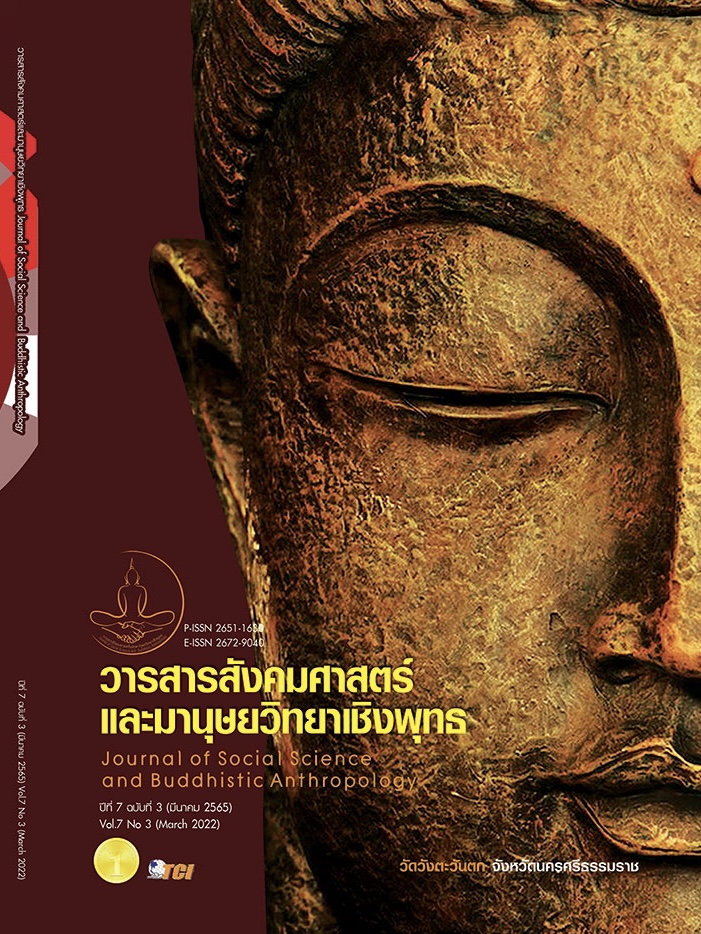DESIGNATING A FILM CITY IN A THAI CONTEXT
Keywords:
Designating a Film City, Diamond Diagram, Thai context identityAbstract
The objectives of this research article were to investigates the suitable film city models for Thailand and studies the identity and cultural elements that link to the establishment of the filming city. This paper is divided into 3 phases: 1) Searching the knowledge body from prototype film cities; 2) Sketching of Thai movie city models reflecting the Thai identity and cultural elements, and 3) Conducting an opinion survey on the movie city. The results found that: 1) factors support the formulation of the film city model includes 1.1) Operational factors - modern technologies and capacity of the Thai personnel are equivalent to the global standard. The filming location is considered the "TOP Location" of the world. Public utilities are competitive compared to neighboring countries. 1.2) Market demand factors - filming from overseas tends to increase. 1.3) Related and supportive industries - Thailand has a large movie studio supporting international operations with relevant businesses. 1.4) Organizational strategy, structure, and competition - the government encourage investors for filming by 15% of the money back from the government and the easing permission. 2) Thai movie city should be located in Chonburi province, with an inclusive service (pre, during, and post filmings) along with facilities and amusement parks; it should contain 6 areas, studio, car parks & office, the scene in the water, forest & urban areas, miniature scene, and cultural promotion area for tourists. 3) Identity of the film city must be expressed in a playful Thai tradition, Thai food, scenes, spaces and theatre reflecting the Thai culture. This includes a team of Thai people who are smiley, have good hearts, love to help others, flexible, and full of everything, both work and play.
References
กรมส่งเสริมการค้าระหว่างประเทศ. (2561). 5 ดีเอ็นเอทางวัฒนธรรม ที่นำมาต่อยอดเป็นธุรกิจสร้างสรรค์ได้. เรียกใช้เมื่อ 19 เมษายน 2564 จาก https://www.creativethailand.net /en/video/detail/126-5-ดีเอ็นเอทางวัฒนธรรม-ที่นำมาต่อยอดเป็นธุรกิจสร้างสรรค์ได้
กลุ่มเลขานุการคณะกรรมการภาพยนตรและวีดิทัศน์แห่งชาติ สํานักนโยบายและยุทธศาสตร์ สํานักงานปลัดกระทรวงวัฒนธรรม. (2559). ยุทธศาสตร์การส่งเสริมอุตสาหกรรมภาพยนตร์และวีดิทัศน์ ระยะที่ 3 (พ.ศ. 2560-2564). เรียกใช้เมื่อ 24 กุมภาพันธ์ 2564 จาก https://www.m-culture.go.th/mculture_th60/download/article /article_20161130090947.pdf
กษิดิศ ปาณฑุเดชะ. (2561). ทิฆัมพร ทีปะปาล จากฝันวัยเด็ก สู่แอนิเมเตอร์วงการฮอลลีวูด. เรียกใช้เมื่อ 3 กรกฎาคม 2561 จาก https://www.matichon.co.th/prachachuen /prachachuen-scoop/news_1026512
กองกิจการภาพยนตร์. (2559). การขออนุญาตสร้างภาพยนตร์ต่างประเทศในราชอาณาจักรไทย. เรียกใช้เมื่อ 5 กรกฎาคม 2561 จาก https://www.thailandfilmoffice.go.th/ebook /B0050/index.html#p=14
กองบรรณาธิการ Positioning. (2547). เมืองกับหนัง (TOWN and MOVIE : Movie Town Business Model). เรียกใช้เมื่อ 31 ตุลาคม 2559 จาก http://positioningmag.com/682
การรถไฟแห่งประเทศไทย. (2562). COMPLETE GUIDE TO SRT 4.0 วารสารรถไฟสัมพันธ์. เรียกใช้เมื่อ 25 สิงหาคม 2564 จาก https://www.railway.co.th/RailwayMiddleFile /NewsAndActImg/1307/
เฉลิมชาตรี ยุคล. (1 กรกฎาคม 2562). รูปแบบเมืองภาพยนตร์และอัตลักษณ์ทางวัฒนธรรมที่เหมาะสมกับประเทศไทย. (เศรษฐา วีระธรรมานนท์, ผู้สัมภาษณ์)
ชาติชาย ไชยยนต์. (25 กรกฎาคม 2562). รูปแบบเมืองภาพยนตร์และอัตลักษณ์ทางวัฒนธรรมที่เหมาะสมกับประเทศไทย. (เศรษฐา วีระธรรมานนท์, ผู้สัมภาษณ์)
นนทกร ทวีสุข. (18 กรกฎาคม 2562). รูปแบบเมืองภาพยนตร์และอัตลักษณ์ทางวัฒนธรรมที่เหมาะสมกับประเทศไทย. (เศรษฐา วีระธรรมานนท์, ผู้สัมภาษณ์)
ปรียนันทนา พงษ์ไพบูลย์ และคณะ. (2558). “ยิ้มสยาม” ในมุมมองของชาวต่างชาติในประเทศไทย. ใน เอกสารประชุมวิชาการ การจัดประชุมเสนอผลงานวิจัยระดับบัณฑิตศึกษา มหาวิทยาลัยสุโขทัยธรรมาธิราช ครั้งที่ 5. มหาวิทยาลัยสุโขทัยธรรมาธิราช จังหวัดนนทบุรี.
พีรชัย เกิดสินธุ์ และคณะ. (2553). ภาพอนาคตอาณาจักรภาพยนตร์ในประเทศไทย : แนวทางการสร้างและบริหารจัดการ. เรียกใช้เมื่อ 20 กุมภาพันธ์ 2561 จาก https://ocac.go.th ///wp-content/uploads/2018/05/53-7.pdf
ภควัต สุพรรณขันธ์. (8 กรกฎาคม 2562). รูปแบบเมืองภาพยนตร์และอัตลักษณ์ทางวัฒนธรรมที่เหมาะสมกับประเทศไทย. (เศรษฐา วีระธรรมานนท์, ผู้สัมภาษณ์)
ภาคภูมิ พลานุวัฒน์. (13 กรกฎาคม 2562). รูปแบบเมืองภาพยนตร์และอัตลักษณ์ทางวัฒนธรรมที่เหมาะสมกับประเทศไทย. (เศรษฐา วีระธรรมานนท์, ผู้สัมภาษณ์)
มนตรี อยู่สมบูรณ์. (5 กรกฎาคม 2562). รูปแบบเมืองภาพยนตร์และอัตลักษณ์ทางวัฒนธรรมที่เหมาะสมกับประเทศไทย. (เศรษฐา วีระธรรมานนท์, ผู้สัมภาษณ์)
รักศานต์ วิวัฒน์สินอุดม. (2552). ยุทธศาสตร์การจัดตั้งอาณาจักรภาพยนตร์และวีดิทัศน์ในประเทศไทย. เรียกใช้เมื่อ 20 กุมภาพันธ์ 2564 จาก https://ocac.go.th///wp-content/uploads/2018/05/52-1.pdf
วีระศักดิ์ โควสุรัตน์. (15 กรกฎาคม 2562). รูปแบบเมืองภาพยนตร์และอัตลักษณ์ทางวัฒนธรรมที่เหมาะสมกับประเทศไทย. (เศรษฐา วีระธรรมานนท์, ผู้สัมภาษณ์)
สมชัย ลีนานุรักษ์. (25 กรกฎาคม 2562). รูปแบบเมืองภาพยนตร์และอัตลักษณ์ทางวัฒนธรรมที่เหมาะสมกับประเทศไทย. (เศรษฐา วีระธรรมานนท์, ผู้สัมภาษณ์)
สมาพันธ์ภาพยนตร์แห่งชาติ. (2558). หนังไทยโกอินเตอร์. เรียกใช้เมื่อ 2 มีนาคม 2561 จาก https://positioningmag.com/7749
สิทธิไชย ไชยันต์. (10 กรกฎาคม 2562). รูปแบบเมืองภาพยนตร์และอัตลักษณ์ทางวัฒนธรรมที่เหมาะสมกับประเทศไทย. (เศรษฐา วีระธรรมานนท์, ผู้สัมภาษณ์)
อุบลวรรณ สุจริตกุล. (3 กรกฎาคม 2562). รูปแบบเมืองภาพยนตร์และอัตลักษณ์ทางวัฒนธรรมที่เหมาะสมกับประเทศไทย. (เศรษฐา วีระธรรมานนท์, ผู้สัมภาษณ์)
Faul, F. et al.. (2007). G* Power 3: A flexible statistical power analysis program for the social, behavioral, and biomedical sciences. Behavior research methods, 39(2), 175-191.
Jassa, T. S. (2020, August 4 ). History and Service of the Film City. (Settha Veerathunmanon, Interviewer)
Kolli, K. (2020, August 10 ). History and Service of the Film City. (Settha Veerathunmanon, Interviewer)
Kumar, S. (2006). Mapping Tollywood: The Cultural Geography of “Ramoji Film City” in Hyderabad. Quarterly Review of Film and Video, 23(2), 129-138.
McGee, H. & Shih, W. (2016). Wanda Studios Qingdao. Harvard Business School. An International Journal, 15(9), 1-4.
Porter, M. E. (1990). The Competitive Advantage of Nations. 1st Edition. New York : Palgrave.
Ramoji Film City. (2018). Realise your celluloid dreams: RAMOJI FILM CITY. Retrieved March 2, 2021, from http://www.ramojifilmcity.com
Downloads
Published
How to Cite
Issue
Section
License
Copyright (c) 2022 Journal of Social Science and Buddhistic Anthropology

This work is licensed under a Creative Commons Attribution-NonCommercial-NoDerivatives 4.0 International License.








